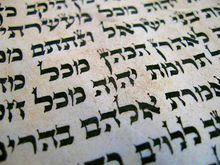| This article needs additional citations for verification. Please help improve this article by adding citations to reliable sources. Unsourced material may be challenged and removed. Find sources: "Tag" Hebrew writing – news · newspapers · books · scholar · JSTOR (March 2022) (Learn how and when to remove this message) |

A tag (Aramaic: תאג, plural tagin, תאגין) is a decoration drawn over some Hebrew letters in the Jewish scrolls of Sifrei Kodesh, Tefillin and Mezuzot. The Hebrew name for this scribal feature is kether (כתר). Tag and kether mean 'crown' in Aramaic and Hebrew respectively.
Placement

In modern practice, the letters Beth, Daleth, He, Heth, Yud and Quf (mnemonic: BeDeQ-ChaYaH בדק חיה) have one tag. The letters Gimel, Zayin, Tet, Nun, Ayin, Tzadi and Shin (mnemonic: Sha´ATNeZ-GaTz שעטנז גץ), as far back as Talmudic times, have 3 tags. Some manuscripts feature embellished tagin on the top line of each column and some also on all occurrences of the Tetragrammaton other than those prefixed with a lamed.
Sefer Tagin


About the 2nd century CE, a work called Sefer Tagin (ספר תאגין or ספר תאגי) emerged attributed to Rabbi Akiva which laid out the 1960 places where modified tagin or letter forms occur in a Torah scroll. In it, the locations of letters which receive a number of tagin which differs from the sha'atnez gatz tradition, e.g. the initial beit of bereshith in Genesis 1:1 having 4 tagin as opposed to the usual 1 and the instances of aleph which bear 7 tagin apiece. According to this work, each occurrence of each letter is to be written with between 0 and 7 tagin, as delineated in the lists contained therein.
Maimonides
This tradition, predating the versification of the Torah text, contains some instruction wherein it is difficult to know what verses are being referenced, thus in the 12th century, Maimonides ruled that though a scribe should do his utmost to incorporate all of the elements of this tradition, called otiyyot meshunot (strange letters), if they are omitted, whether in full or in part, the scroll would not be ruled as pasul (invalid).
Interpretation
In a notable sugya, in which Moses sees Rabbi Akiva (Menachot 29b), a story in the Babylonian Talmud states that tagin were originally added to the text by God at Mount Sinai, and that Rabbi Akiva would use their presence in order to derive numerous laws by midrash (rabbinic exegesis).
In kabbalistic thought, each tag has special significance and meaning.
See also
References
- Talmud Bavli - Menachos 29b.
- cf. Soferim 9:1
- Brian Tice, Sefer Tagin (ספר תאגין): An Ancient Sofer Manual (Grand Rapids, Mich.: Yiddishkeit 101, 2021). ISBN 979-8-4929-0692-4.
- Moshe ben Maimon (Rambam), Mishneh Torah, Hilkhot Sefer Torah uMezuzah v'Tefillin 7:8.
- Menahot 29b; Shabbat 89a
- Etz Chaim - Shaar TaNT"A.
External links
- Learning About Tagin (UnderstandingHebrew.com)
- Sofer (scribal) penmanship for ritual STA"M use of Kulmusim quill
- Halachic origins in Gemara, the Babylonian Tractate Menachot 29
- Conventions in use
| Jewish scribes (soferim) | ||
|---|---|---|
| Lists of scribes |  | |
| Ktav Stam | ||
| Documents | ||
| Related articles | ||
| Category:Jewish scribes (soferim) | ||
| Hebrew language | |||||||||||||
|---|---|---|---|---|---|---|---|---|---|---|---|---|---|
| Overviews | |||||||||||||
| Eras | |||||||||||||
| Reading traditions | |||||||||||||
| Orthography |
| ||||||||||||
| Phonology | |||||||||||||
| Grammar | |||||||||||||
| Academic | |||||||||||||
| Reference works | |||||||||||||